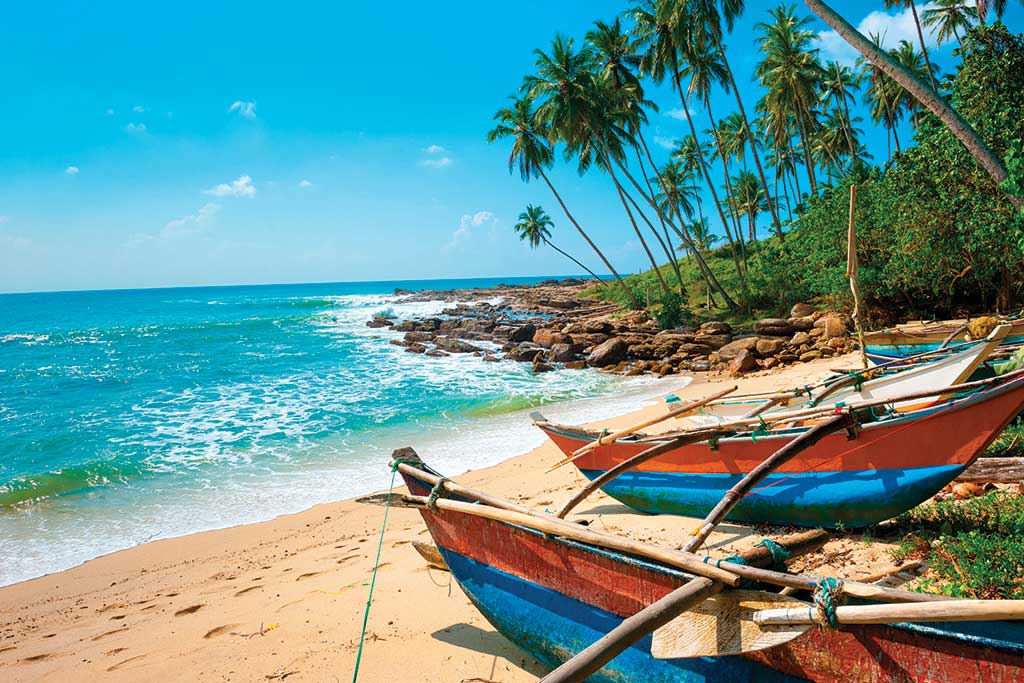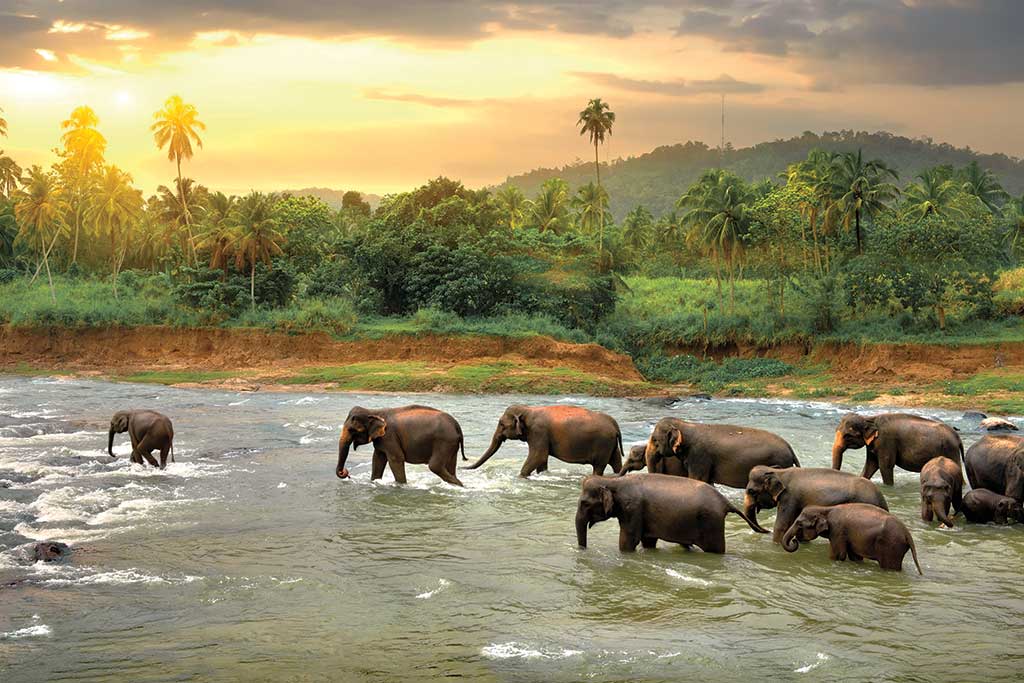Diners choose exactly which sea creatures they want to eat, specify whether they should be grilled, steamed, wok-fried, or deep-fried, and then choose from over two-dozen saucing and seasoning options, from three different Sri Lankan preparations (the thick coconut curry is highly recommended) to Chinese, Thai, and Indian iterations. If you’re saddled with unadventurous companions, they can always default to Hollandaise or lemon butter and capers.
While customer creativity is encouraged, the knowledgeable waitstaff does not hesitate with matchmaking guidance, and steering customers away from ill-advised combinations.
The following morning, we began a scenic drive to the central city of Kandy, in the country’s south central hills, stopping along the way to visit one of Sri Lanka’s typical commercial spice gardens, where many plants, each of which is typically raised on its own plantations, are presented together along the paths of a shady terraced garden.
Created as tourist attractions, these living exhibitions are nonetheless worthwhile, both for the crash courses they provide in medicinal botany, Sri Lanka’s history as a spice-trading capitol, and the art of salesmanship that borders on showmanship.
Just beware that the country “apothecary” you’ll reach at tour’s end sells products you’ll find for a fraction of the price at Sri Lankan drug-stores and supermarkets.
That said, it was nonetheless delightful to trail along behind the wiry, whippet-like proprietor, Mr. Liyanage, as he led us from berry bush, to vine, to tree, cheerily repeating “Sirs. Madams. My next presentation is…” before explaining that a single teaspoon of juice pressed from one particular wild ginseng plant would energize us more than a can of Red Bull; that local honey mixed with wild baby pineapple had almost magical slimming powers; or that a particularly foul-smelling blend of pulverized leaves and herbs would do wonders at removing body hair (A patch of my left calf participated in a demonstration, ending up truly smooth and truly stinky).
After arriving in Kandy, we tooled around in the city’s picturesque central manmade lake, created as a vacation spot for the region’s last Sinhalese king in 1807, just eight years before the kingdom was colonized by the British.
Next, Aitken Spence arranged to have our group pay a visit to the hilltop home and studio of the painter Rahju. With his flowing beard, beaded necklaces, and a sense of floaty remoteness, even when speaking directly to guests over a cup of tea, the half-Sri Lankan, half-Norwegian, Rahju encapsulated the mysterious Eastern guru-type that fascinated young Americans in the early 1970s. In fact, while showing us his enormous canvases of mythical landscapes and magic-infused nature imagery, Rahju showed us a photo of his personal master, the late Bhagwan Shree Rajneesh.

Jungle Sunrise in Sri Lanka
Rajneesh was known for a fleet of orange limousines and a penchant for “spiritual” orgies when he led a commune in Oregon in the 1980s. He was eventually deported from the United States.
Before we parted ways with Rahju, having declined the opportunity to purchase his $15,000 canvas equivalents of healing crystals, he graced us with a few tunes played on his electric sitar. “P.T. Barn-Ommmm,” I whispered under my breath.
To bring the day to a more traditional finish, we moved on to Kandy’s most esteemed attraction, the Temple of the Tooth. After crossing a moat and passing through a stone gateway large enough for elephants to enter, visitors make their way through chambers of ornately carved and gilded wood and marble to a central, two-story shrine.
It is here that, in the smallest of seven jewel-encrusted gold caskets, nested one inside the next like Russian dolls, is a tooth removed from the cremated remains of the Buddha in 543 B.C.E.
Paintings throughout the temple complex create an illustrated bicuspid biography, tracing the tooth’s movements from India to Kandy over the course of nearly 2,000 years, at one point hidden in the hair of a princess.
Whether one believes these stories or not, it is hard not to be stirred by the sense of spiritual devotion throughout the temple grounds. Faithful Buddhists mound hallway-long tables with devotional offerings of fruit and flowers. Saffron-robed monks by the dozen wander the halls between prayer ceremonies.
Our itinerary had been timed so that we entered the temple complex just as the sun had begun to set. At our visit’s end, we stepped out from the temple sanctuaries into the warm night air and were greeted by the spectacle of a giant glass chamber. Within it, thousands of small candles flickered, each one lit with another pilgrim’s prayer.
It felt as if that twinkling beneficence had followed us when, an hour later, we sat down to savor a starlit alfresco dinner. Traditional Sri Lankan dishes were served on the slate-tiled patio of the distinctly non-traditional Theva Residency.
Set amid the labyrinth of winding roads that climb the Kandy hill-sides, this utterly surprising, ultra-modern ten-suite hotel feels like the lair of a St. Barth’s billionaire or James Bond super-villain. The private rooms and public lounges have floor-to-ceiling windows with panoramic views of a valley below. An infinity pool and sauna are unexpected amenities for such an intimate property.
While bearing the influence of southern Indian cooking, Sri Lankan cuisine features some uniquely characteristic dishes well worth sampling:
Polos deserves attention from American vegetarians: the sinewy flesh of unripened jackfruit is slowly stewed in a fragrant blend of spices until the fruit, too young to have sweetened, absorbs their flavors and takes on a tender chew and texture surprisingly similar to stewed beef.
Egg hoppers are fried eggs served in crisp, crêpe-like edible bowls made from fermented rice flour and coconut milk. The richness of the egg yolk is set off by a slight tanginess to the dough (foodies familiar with the Ethiopian bread injera will find the taste similar), and dabs of the spicy relishes known as sambals, added to one’s taste. While egg hoppers are a popular street food, travelers are well-vised to restrain their curbside appetites and enjoy hoppers as part of a hotel breakfast. And don’t miss out on gotu kola sambol by mistakenly assuming it’s a spicy condiment. It’s one of the few unsauced fresh green vegetable dishes in Sri Lanka, something you’ll be happy to see after many a plate of delicious (but belly filling) curries.


Tropical Beach in Sri Lanka
On our drive out of Kandy the next morning, we paid a visit to the headquarters of Hemachandras Limited, one of the most famous Sri Lankan gemstone companies. The southeastern part of the island is one of the world’s most famous mining sites for precious stones, including the distinctive blue sapphires used in Princess Diana’s engagement ring and earrings.
In addition to eye-popping jewelry showrooms, Hemachandras provides an opportunity to learn about gem geology and mining, and to tour their workshops where raw stones are carved, faceted, and polished through labor-intensive handwork.
Our next two days were a luxurious non-stop tea party. The Ceylon Tea Trails Resort is located at an altitude of 4,000 feet, amid the rolling green hills of Sri Lanka’s Central High- lands, a UNESCO World Heritage Site. With just 21 guest rooms divided among four “bungalows” (I’d never associated bungalows with butlers before, but, when on a tea plantation…), this unique hostelry offers an idyllic setting for long country walks, scenic bike rides on winding low grade roads (bicycles are available for guest use), pool- side lounging with lush valley views, and learning about Sri Lanka’s heritage in the tea trade.
Guided by a professional planter from the Dilmah tea company, which operates the intimate, all-inclusive resort on its working grounds, guests wind their way through acres of tea plants, learning how growing locations are selected and cultivated over the years. Dozens of women wearing head scarves and colorful cotton dresses delicately pluck the smallest new leaves and buds, slowly filling the large cloth sacks they carry on their shoulders.
There’s also the opportunity to visit a working tea factory, over 100 years old, to learn how freshly picked leaves are processed into loose tea and tea bags. It’s fascinating, and charming, to see how old-fashioned the process is: loud and hot, done on huge metal agepatinaed machines.
And if you’re just a casual tea drinkier, as I am, you’ll be surprised to learn that black tea, white tea, and green tea all come from the same plant; it’s the way they’re heated, dried, crushed and manipulated that makes them different. You’ll also learn how tea is tasted and graded for quality.


